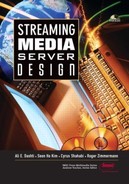Chapter 2. SINGLE DISK PLATFORM SM SERVERS
The fundamental functionality of SM servers is a hiccup-free display of SM. However, just supporting a continuous display is not enough in the design of SM servers because many real applications, especially commercial ones such as movie-on-demand systems that concurrently service multiple users, require maximizing the performance of servers for cost-effective solutions. Thus, the following performance metrics are important in the design and implementation of SM servers:
Throughput, i.e., the number of simultaneous displays that can be supported by a SM server.
Startup Latency, i.e., the amount of time, elapsed from when a display request arrives at the system until the time the actual display is initiated by the system on behalf of this request.
Throughput, in general, is closely related to another important metric of SM servers, namely cost per stream (CPS). If a technique supports a higher throughput with fixed resources than others, it provides for a more cost-effective solution (i.e., lower CPS)[1].
[1] Throughout this textbook (in general) and this chapter (in particular) we compare alternative designs based on these metrics.
Magnetic disk drives have been the choice of storage devices for the design of SM servers due to their high data transfer rate, large storage capacity, random access capability, and low price. Therefore, many studies have investigated hiccup-free display of SM using magnetic disk drives [9], [12], [13], [26], [59], [136], [138], [175], [183], [70].
This chapter describes different techniques in support of a hiccup-free display of SM with a single disk drive. Even though a single disk server is not practical in many applications, we still can describe many fundamental concepts and techniques in designing SM servers without introducing much higher complexity at the beginning. Most concepts and techniques can be straightforwardly applied to more complicated multi-disk platforms described in the later chapters.
In Section 2.1, we first describe the characteristics of modern disk drives and low-level SCSI programming interface to these drives. In Section 2.2, we present an overview of SM techniques discussed in this chapter. Next, in Section 2.3, we present three alternative disk scheduling techniques for SM display: Simple, SCAN, and GSS. Subsequently, in Section 2.4, we present a constrained data placement techniques, namely: REgion BasEd bloCk Allocation (REBECA). Finally, in Section 2.5, we describe four alternative techniques to support SM display using a single multi-zone disk: track pairing (TP), logical track (LT), FIXB, and VARB.
